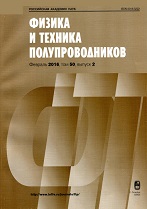|
|
Fizika i Tekhnika Poluprovodnikov, 2018, Volume 52, Issue 4, Page 481
(Mi phts5877)
|
 |
|
 |
This article is cited in 2 scientific papers (total in 2 papers)
XXV International Symposium ''Nanostructures: Physics and Technology'', Saint Petersburg, June 26-30, 2017
Quantum wells, Quantum wires, Quantum dots, band structure
Luminescence of ZnMnTe/ZnMgTe heterostructures with monolayer manganese inclusions in ZnTe quantum wells and its behavior in a magnetic field
I. V. Shtromab, V. F. Agekyanb, A. Yu. Serovb, N. G. Filosofovb, R. R. Akhmadullinc, D. E. Krizhkovd, G. Karczewskie
a St. Petersburg Academic University, Russian Academy of Sciences,
194021 St. Petersburg, Russia
b St. Petersburg State University, 199034 St. Petersburg, Russia
c Ioffe Institute, 194021 St. Petersburg, Russia
d Institute for Physics of Microstructures Russian Academy of Sciences,
603950 Nizhny Novgorod, Russia
e Institute of Physics, Polish Academy of Sciences, Warsaw, Poland
Abstract:
Light emission from ZnMnTe/ZnMgTe structures with the quantum wells ZnTe containing monolayer manganese inclusions and quantum wells Zn$_{0.45}$Mn$_{0.15}$Te were investigated under the different excitation conditions. The heavy-hole exciton $\sigma^+$ and $\sigma^-$ magnetic components show the unusual behavior concerning their energy shifts and intensities. It is possible to explain the Zeeman splitting of the heavy exciton emission band if the following factors are taken into account. Firstly, ZnMnTe/ZnMgTe quantum well structures are of the type II due to the strains as concerns to the electron and heavy hole. Secondly, the electron and hole magnetic sublevels population is far from equilibrium due to the fast energy transfer from the electron- hole system to the 3$d$-shells of magnetic ions.
Citation:
I. V. Shtrom, V. F. Agekyan, A. Yu. Serov, N. G. Filosofov, R. R. Akhmadullin, D. E. Krizhkov, G. Karczewski, “Luminescence of ZnMnTe/ZnMgTe heterostructures with monolayer manganese inclusions in ZnTe quantum wells and its behavior in a magnetic field”, Fizika i Tekhnika Poluprovodnikov, 52:4 (2018), 481; Semiconductors, 52:4 (2018), 514–518
Linking options:
https://www.mathnet.ru/eng/phts5877 https://www.mathnet.ru/eng/phts/v52/i4/p481
|


| Statistics & downloads: |
| Abstract page: | 41 | | Full-text PDF : | 10 |
|



 Contact us:
Contact us: Terms of Use
Terms of Use
 Registration to the website
Registration to the website Logotypes
Logotypes